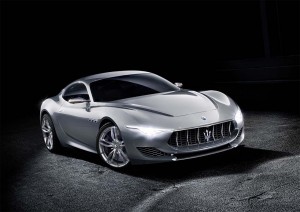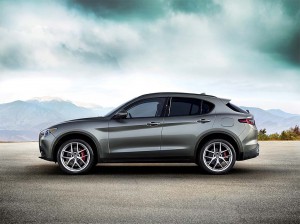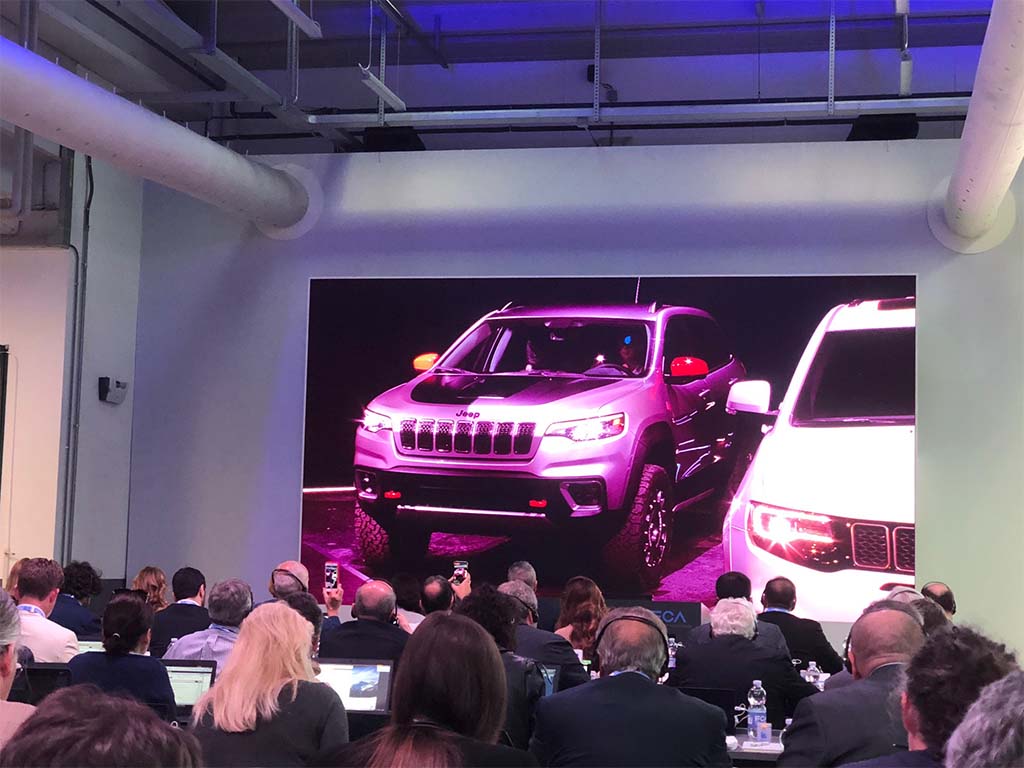(This story has been revised to update plans for Jeep’s pickup and a midsize pickup from Ram that, CEO Marchionne now says will come to the U.S. market.)
In a sweeping presentation designed to give analysts, investors, media and potential buyers a good look at its future, Fiat Chrysler Automobiles executives are spending a day detailing their plans for the company and its various brands.
At the midway mark, as they break for lunch, they’ve already lifted the kimono far enough to show what’s coming for the Jeep, Ram, Maserati and Alfa Romeo brands and, in a nutshell, it can be summed up as more products targeting lots more volume and much bigger margins.
The new five-year plan will be the last crafted under the guidance of Sergio Marchionne, the 65-year-old executive who helped pull off the pairing of two struggling manufacturers to form Fiat Chrysler Automobiles. His third five-year plan, Marchionne stressed that “The true finish line is the one always yet to come.”
As he prepares to hand over the reins to an as yet-unnamed successor – whom many believe will be Jeep brand boss Michael Manley – Marchionne stressed his intent to leave behind a company “prepared to deal with any challenge.” And in the process, he said he expects that by the time he steps down later this year, FCA will have eliminated its industrial debt, providing a new level of “security and strength” for the company and its shareholders.
The real strength, of course, will come in the form of competitive new products, and each of the four brands that presented on Friday morning will have lots more to offer over the course of the five-year plan – with a particular emphasis on utility vehicles.
Equally significant, for a company that had long disdained electrification as a money-losing technology with little support from buyers, FCA will be plugging in on a large scale over the next five years.
(Waymo planning to acquire up to 62,000 Chrysler Pacifica Hybrids. Click Here to find out why.)
Here’s a look at what each of the brands has in store:
Jeep:
There should be little surprise the Jeep brand was the first to lay out its five-year plan. In 2013, as the current five-year plan got underway, it generated a mere 730,000 sales. For 2018, Jeep is on track to hit 1.9 million, and it has been transformed from a largely American brand into a truly global marque.
(Jeep truck due in 2019. Click Here for details.)
It helps, of course, that markets around the world are rapidly shifting away from conventional sedans and coupes to SUVs and CUVs. Ironically, Jeep hasn’t done as good a job as it might to capitalize on that transition. Consider that it currently builds just one of every 17 utility vehicles sold around the world. The target for the new five-year plan is to boost that to one in 12 and, while it’s not a formal corporate target, Manely said his personal goal is to boost that to one in five – perhaps during his tenure as CEO, if he does, indeed become Marchionne’s successor.
As for new products, we can look for:
- A new mini-Jeep, sized below the current base model, the Renegade;
- The long-awaited Jeep pickup for which the old Wrangler plant is now being retooled for a launch “next year”;
- A three-row version of the Grand Cherokee due in mid-2019; and
- The full-size Grand Wagoneer set to return in 2020.
But that’s only part of what Jeep will be introducing. It also plans to expand the range of high-performance TrackHawk models. First introduced as a Grand Cherokee variant, look for two more TrackHawks to come.
Then there’s the all-new DesertHawk, an even more “desert-rated” version of the TrailHawk, to debut during the first quarter of 2020.
And within five years, Manley added, “All (Jeep) models will have a range of electrification options,” that appear to start with electric boost and which may push all the way up to full electrification. The brand boss said he was optimistic buyers will accept electric drive technology because, with Jeep, it won’t be used just to meet emissions regulations but “to bring a higher level of off-road capabilities,” such as low-speed crawl.
He also said he expects to see electrification gain a strong foothold in China – no surprise considering new regulations promoting sales of “advanced” powertrain technologies. In turn, Manley said he’s confident Jeep buyers will pay a bigger premium to allow the brand to recover the cost of the technology.
Manley also noted Jeep is getting ready to launch a subscription service that will eventually roll out across the U.S. and in some other markets, if well-received. It appears there will be varying price structures that will allow subscribers to switch between different models according to their needs and whims.
(FCA backs off support for CAFE rollback. Click Here to find out why.)
Ram:
Manley was back giving insight into FCA’s commercial truck division in his dual role as Ram brand boss. The youngest of the maker’s marques, it was split off from Dodge in a bid to more clearly define its roll. Ram is looking for a breakthrough year in 2018, largely due to the launch of an all-new half-ton pickup. If all goes according to plan, sales will hit 770,000, said Manley, up from 590,000 last year, and the best annual performance by the brand since it set a 723,000 vehicle sales record in 1999.
It helps, according to several recent studies, that Ram now has the highest brand loyalty among U.S. pickup truck competitors. What it doesn’t have is anywhere near the highest average transaction price. Ram lags segment-leading competitors Ford and General Motors in sales of vehicles priced above $39,000, but that’s something the FCA division hopes to change with the upcoming launch of the all-new TRX truck, based on a popular concept model of a few years back.
“We think it’s time for (Ford’s F-150) Raptor to have some serious competition,” Manley declared, though he would only reveal that the TRX – often referred to as the T-Rex – will join the line-up sometime “over the next five years.”
Ram will be looking to fill some yawning gaps in its line-up Manley said. That includes an all-new midsize pickup – this one of its own making, and not borrowing a platform from Japan’s Mitsubishi. For those hoping to see a downsized Ram ready to compete with the likes of the Chevrolet Colorado, however, don’t hold your breath.
Initially, there were indications during the event that the midsize Ram pickup would not come to the U.S. market but, in an end-of-the-day Q&A session, Marchionne said it will reach American dealers, “Probably (in the) ’21-ish” timeframe.
Separately, Manley said there also will be a new version of Ram’s Pro Master City van.
Maserati
When FCA’s current five-year plan got underway, the Italian luxury brand was little more than a global after-thought, sales in 2000 a mere 6,000 vehicles worldwide. Last year, that surged to 50,000, and while that reflected an overall expansion of the Maserati line-up one model really deserves credit: the first-ever Maserati SUV. The Levante now accounts for 53% of the brand’s sales and has proved critical to its success in the U.S. and Chinese markets, in particular.
Not surprisingly, with the overall, global growth of the premium vehicle market, FCA is counting heavily on Maserati to continue building momentum. And, also no shock, it expects much of that will come from an expanding line-up of SUVs. By the end of the new five-year plan we’ll be seeing both an all-new D-segment utility vehicle, as well as a makeover of the Levante.
Look for remakes of the Quattroporte and Ghibli models, as well.
Meanwhile, Maserati will be getting a new flagship, the eagerly awaited Alfieri coming as the production version of the concept vehicle that stunned audiences at the Geneva Motor Show a few years back. The Alfieri, said Maserati brand boss Tim Kuniskis “will capture the essence of (the brand’s) 100 years.”
The Alfieri will be based on an all-new aluminum spaceframe and offered in both hardtop and cabriolet versions. Its modular chassis will be able to be adapted to handle a mix of powertrains, including a plug-in hybrid with electric all-wheel-drive capable of launching it from 0 to 100 kmh (0 to 62.5 mph) “in the 2-second range,” promised Kuniskis.
Look for Maserati to begin phasing out of diesel while putting more and more emphasis on electrification. In fact, there will be four all-electric models available before the end of the 5-year plan, including versions of the Quattroporte, Levante and both the cabrio and hardtop Alfieri.
Significantly, Kuniskis revealed, all Maserati powertrains will now be sourced exclusively from Ferrari. That includes Maserati battery-electric vehicles. And that appears to confirm long-standing expectations that Ferrari itself will be bringing out an all-electric sports car in the near future.
Kuniskis didn’t wait to answer a question that many observers were certainly hoping to ask. Is Maserati hoping to use its new electric models to compete with the likes of Tesla and Porsche? “We are,” he declared.
Alfa Romeo:
When the current five-year plan began, Alfa was even more invisible than Maserati, completely absent from the key North American market for close to a quarter century. It is rapidly increasing its presence with a series of product introductions capped by the Stelvio SUV. Like the Maserati Levante, Alfa’s future almost certainly will center around a growing utility vehicle line-up, though it will continue to grow its sedan, coupe and sports car range, as well.
The brand, said Kuniskis, has made “a commitment to reset everything,” in a bid to boost sales from last year’s 109,000 to 170,000 by the end of 2018. And by 2022, the goal is 400,000.
Over the course of the new plan, expect to see two new utility vehicles sandwiching the Stelvio, a compact crossover and a full-size ute.
Meanwhile, Alfa will add long-wheelbase versions of key models, largely with an eye on China, where a sizable share of owners continue to ride in back and leave the driving to chauffeurs.
There will be several new performance models, as well:
- An all-new Alfa Romeo 8C adopting a carbon fiber body and platform. It will deliver more than 700 horsepower through a hybrid drivetrain pairing a mid-mounted twin-turbo gas engine and an electric motor driving the front axle. Expect 0 to 100 kmh times of under 3 seconds; and
- A new Alfa GTV reviving one of the brand’s legendary nameplates. The four-passenger model will make over 600 horsepower using an electrically boosted gas engine. Power will be delivered to all four wheels and the GTV will feature torque vectoring.
As with Maserati, expect to see Alfa Romeo put an emphasis on electrification going forward though, Kuniskis stressed, it is not “a compliance move but a performance booster.” Look for Alfa to add e-boosters – essentially motor-driven turbocharging – hybrids and plug-in hybrids.
FCA has been promising big things for Alfa, though not everyone is yet convinced. For his part, Kuniskis sees great opportunity for the brand to differentiate itself in an era when “the industry is in danger of being commoditized. The only thing that will differentiate you in an industry with 200 brands,” he added, “is the strength of your brand.”
We’ll report in with more on FCA’s plans once the afternoon session gets underway in Milan.






“We’ll report in with more on FCA’s plans once the afternoon session gets underway in Milan.” I hope so. Still wanting to know what the plans are for Chrysler and, more importantly, Fiat. Also, how come we never hear anything about Lancia? Is it still being manufactured? At one time (or so I believe) it was hypothesized that a rebadged Lancia would be sold here as Chrysler.
Allen,
We’ve reported extensively about Lancia, which is basically just a Chrysler re-badge solely for the Italian market. See the more in-depth piece on Fiat and Chrysler brands going up over night. We wanted to nail down more of the story, not just rush it out.
Paul E.
Thank you Paul. Looking forward to your always excellent reports.
Is Chrysler dead?
I see no mention other
than Waymo Van in the plan.
Bob,
We wanted to do a little more research. See the story that will be going live in the early hours of Monday AM.
Paul E.